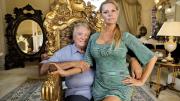No sooner had the citizenry chosen Barack Hussein Obama, J.D. ’91, to be their forty-fourth president, than pundits began comparing him to the thirty-second one. “Suddenly, everything old is New Deal again.…F.D.R. is in,” declared Paul Krugman in an op-ed piece in the New York Times headlined “Franklin Delano Obama.” Time put a beaming Obama costumed as Roosevelt on its cover, and other media piled on the theme.
FDR, A.B. 1904, LL.D. ’29, is in at Harvard, too—and about time, some would say. While there are various tributes scattered around the place to his distant cousin Theodore, A.B. 1880, LL.D. 1902, the twenty-sixth president—the rich Theodore Roosevelt Collection in Houghton Library, most notably—no memorial to Franklin exists. But if the necessary funds can be raised in these depressed times, that lack will be remedied within a year (to mark progress, go to www.fdrsuite.org). Judith and Sean Palfrey, master and co-master of Adams House, imagined restoring the suite of rooms in what is now B-entry—two bedrooms, sitting room, and bath— that Franklin and his mother, Sara, furnished luxuriously and that he occupied as an undergraduate. One year ago the Palfreys found just the volunteer to spearhead the project, Michael Weishan ’86, an Adams alumnus, landscape designer, writer, and former host of The Victory Garden on PBS. He specializes in piecing together historical landscapes from archival sources, exactly the sort of research needed to rebuild Roosevelt’s digs. When restored, they will serve as a memorial museum and as remarkable rooms for University guests. Perhaps Franklin Delano Obama would enjoy a stay.
Also ran: Independent candidate Ralph Nader, LL.B. ’58, Obama’s fellow Law School alumnus and rival to succeed George W. Bush, M.B.A. ’75, left his home in Winsted, Connecticut, early on October 25 to stump in Massachusetts. He aimed that day to set a Guinness World Record for most speeches in 24 hours. To attain the goal, he had to give at least 15 spontaneous speeches at least 10 minutes in length on different topics at different venues and with at least 10 people in attendance who hadn’t come with him. His campaign headquarters reported next day that he had triumphed. Taking questions, signing up supporters, and fundraising along the way, Nader delivered 21 speeches in as many municipal jurisdictions, speaking for a total of at least 255 minutes to more than 1,000 people. Among his stops were a deli, a farmers’ market, a library, and the front of the Federal Reserve Bank of Boston, where he called “that monstrous bailout bill…taxation without representation.” If Nader could keep up that pace for the entirety of a presidential campaign—say, the campaign of 2016—might he become the ninth person with a Harvard degree (see “Brevia,” page 63) to serve as president?








